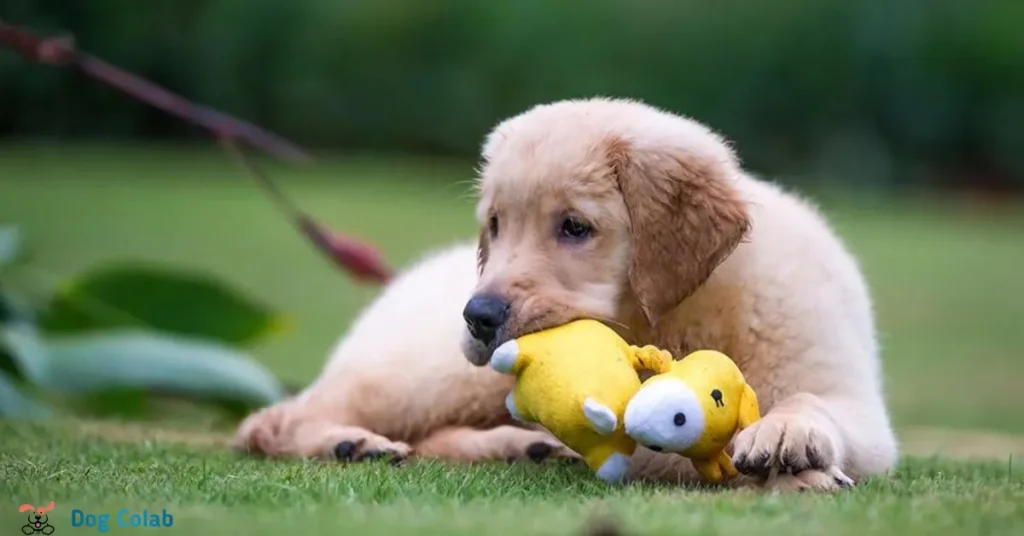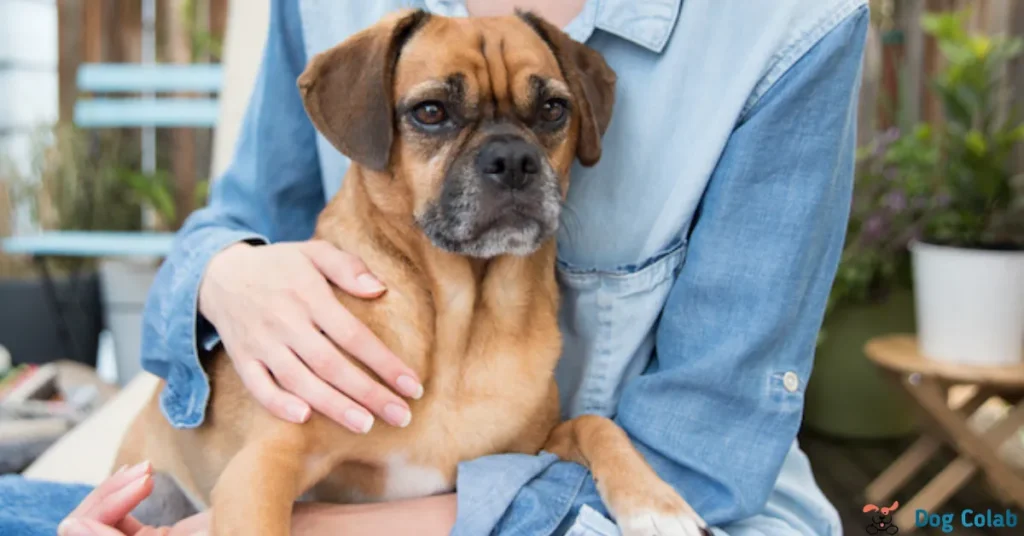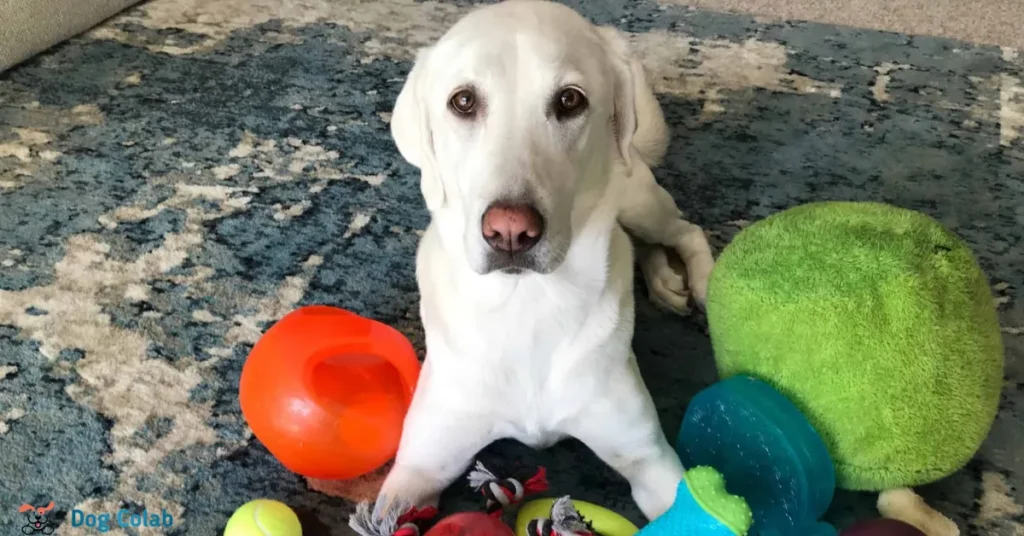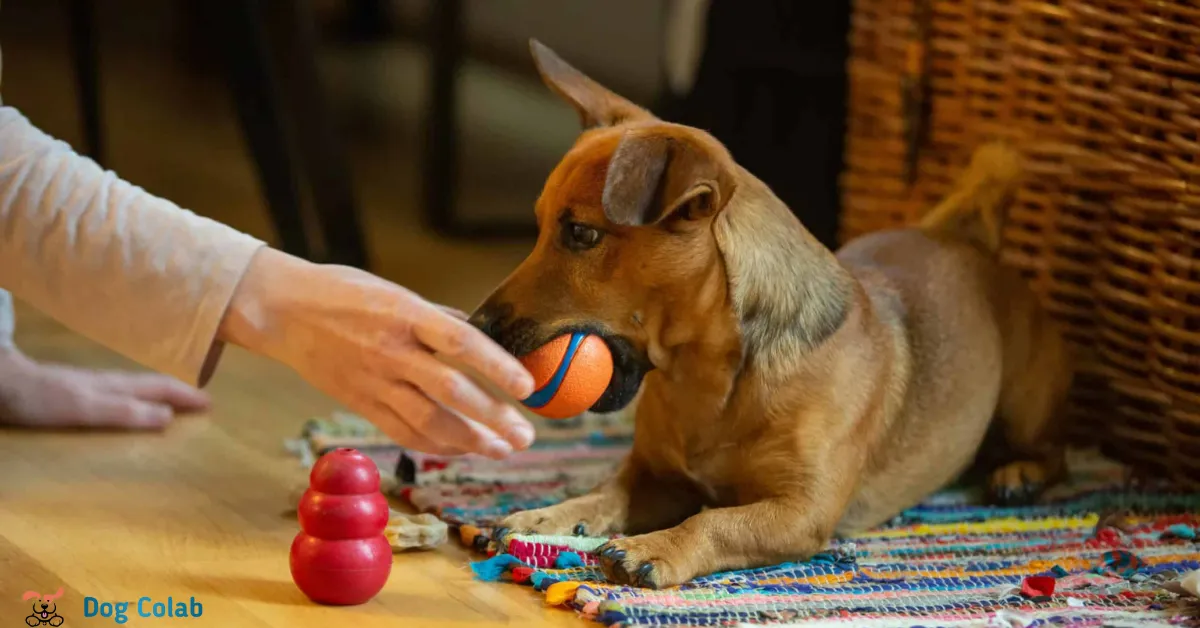Rescue dogs often come from various backgrounds and may not have had the opportunity to learn how to play with toys. Whether they’ve experienced neglect, abuse, or simply never had toys introduced to them, playing with toys is not only fun but also a great way to keep your furry friend mentally and physically stimulated.
Here, we will provide a detailed step-by-step guide on how to teach a rescue dog to play with toys or encourage your rescue dog to play with toys.
Why Is My Rescue Dog Not Playing With Toys?
There could be several reasons why your rescue dog is not playing with toys. Here are some potential reasons why your rescue dog may not be interested in playing with toys.

1. Fear or Anxiety
If your dog has a traumatic or stressful past, they may be fearful or anxious, making it difficult for them to engage in play. It’s important to create a safe and comfortable environment for your dog and give them time to adjust to their new surroundings.
2. Health Issues
If your dog is not feeling well or is in pain, they may not have the energy or desire to play. By consulting with a veterinarian, you can rule out any medical issues.
3. Lack of Exposure
Some rescue dogs may not have been exposed to toys or play in their previous environment. They may not know how to interact with toys, so it can take time to introduce them gradually and teach them how to play.
4. Age and Temperament
Some dogs are naturally less playful than others. Age can also play a role; older dogs may be less interested in play than puppies. Understanding your dog’s temperament and preferences is important in choosing the right type of toy.
5. Socialization
If your rescue dog hasn’t been properly socialized with other dogs or people, they might not understand how to play or interact with toys. Socialization and training can help address this issue.
6. Stress or Insecurity
New environments and changes in their life can be stressful for rescue dogs. They might not feel secure enough to engage in play until they settle in and build trust with their new family.
7. Type of Toys
Not all dogs are interested in the same types of toys. Some dogs prefer soft plush toys, while others like rubber or interactive toys. Experiment with different types of toys to see if your dog has a preference.
Read More:- Why do dogs ignore me.
Benefits of Playing Rescue Dogs
Playing with rescue dogs, or adopting them as pets, can offer several benefits, both for the dogs themselves and for the people who choose to welcome them into their lives. The following are some of the key benefits.

- Saving a Life: One of the most significant benefits of adopting rescue dogs is that you are saving a dog from potentially dire circumstances. Many rescue dogs come from shelters, abusive situations, or neglectful environments. Giving them a loving home can literally be a lifesaver.
- Unconditional Love: Dogs are known to show unconditional love and loyalty. Rescue dogs often have a special appreciation for their new owners and can form incredibly strong bonds. The feeling of being loved and needed by a rescue dog is immensely rewarding.
- Emotional Well-being: Interacting with rescue dogs has been shown to reduce stress, anxiety, and depression. The act of playing and bonding with a dog can trigger the release of endorphins, which are natural mood lifters.
- Physical Activity: Playing with dogs requires physical activity. This encourages owners to exercise more, which is beneficial for their overall health. It’s a win-win situation as dogs need exercise too.
- Companionship: Rescue dogs can provide companionship and alleviate loneliness. They make excellent partners for people who live alone or have limited social interactions.
- Teaching Responsibility: Taking care of a rescue dog teaches responsibility. Owners need to feed, groom, and provide medical care for their pets. This can be a valuable life lesson for children and adults alike.
- Improved Mental Stimulation: Dogs, including rescue dogs, can be mentally stimulating to interact with. Training, teaching tricks, and solving problems together can help keep your mind sharp.
- Community Involvement: Adopting a rescue dog often connects you with local animal welfare and rescue communities. This can lead to a sense of community involvement and volunteer opportunities.
- Personal Growth: Caring for a rescue dog can promote personal growth and development. It requires patience, empathy, and the ability to adapt to the unique needs and characteristics of the dog, which can be a very enriching experience.
Read More:- Why do dogs shake after you pet them.
How To Teach A Rescue Dog To Play With Toys?
Teaching a rescue dog to play with toys can be a rewarding experience but many rescue dogs come from challenging backgrounds and may not be accustomed to playing with toys. Follow these simple steps to help on how to teach a dog to play with toys.

1: Create a Safe Space
Start by creating a safe and comfortable environment for your rescue dog. Ensure that there are no distractions or potential threats in the area where you plan to introduce toys. A quiet, familiar space will help your dog feel at ease.
2: Choose the Right Toys
Not all toys are created equal, and some may be more appealing to your dog than others. Begin with a variety of toys, such as squeaky toys, soft toys, and puzzle toys. Observe your dog’s reactions to determine which toys they prefer.
3: Introduce the Toy Slowly
Your rescue dog may not be accustomed to toys, so take it slow. Gently present the toy to your dog and allow them to investigate it at their own pace. Use positive reinforcement, like treats or gentle praise, when they show interest in the toy.
4: Make Playtime Fun
Engage your dog in play by using the toy in an interactive way. Toss it gently, roll it, or play tug-of-war if the toy is appropriate for that. Be enthusiastic and encourage your dog to join in the fun. However, be patient; it may take some time for your dog to understand how to play.
5: Use Treats for Motivation
To further motivate your rescue dog to play with toys, incorporate treats. For instance, you can hide a treat in a puzzle toy or squeak a toy just before offering a treat. This positive association will make your dog more interested in the toy.
6: Play Regularly
Consistency is key. Make playtime a daily routine to help your dog become more comfortable with toys. Even if your dog doesn’t show immediate interest, keep trying. Some dogs take longer to adjust to new experiences.
7. Rotate Toys
Rescue dogs can get bored with the same toys over time. To maintain their interest, rotate their toy selection regularly. This keeps their playtime engaging and exciting.
8: Respect Your Dog’s Pace
Every dog is unique, and your rescue dog might have some hesitations about playing with toys due to past experiences. Be patient and don’t force your dog into play. Respect their pace and comfort level, and never use toys as a form of punishment.
9: Social Play
If your rescue dog enjoys the company of other dogs, consider introducing them to a well-behaved and sociable canine friend. Dogs often learn from each other, and your dog may become more interested in toys through social play.
10: Be Patient and Persistent
Teaching a rescue dog to play with toys may take time and patience. Some dogs may never develop a strong interest in toys, and that’s okay. You should create a loving and comfortable environment for your pet.
How To Help Your Rescue Dog To Relax and Decompress?
Helping rescue dogs relax and decompress is crucial to their well-being, as they may have experienced trauma or stress before finding their forever home. Here are some steps to help your rescue dog settle in and feel comfortable.

- Create a Safe Space: Set up a quiet, comfortable area where your dog can retreat to when they feel overwhelmed. This space should have a cozy bed, water, and some toys.
- Give Them Time: Understand that your dog may need time to adjust to their new environment. Be patient and allow them to explore and get acclimated at their own pace.
- Stick to a Routine: Dogs thrive on routine. Establish a consistent daily schedule for feeding, walks, and playtime. Predictability helps reduce anxiety.
- Use Positive Reinforcement: Give treats, praise, and affection for good behavior. This builds trust and reinforces positive associations.
- Socialization: Gradually introduce your dog to other dogs and people in controlled environments. Socialization is essential, but it should be done at a pace that is comfortable for your dog.
- Obedience Training: Enroll your furry friend in basic obedience classes. This not only helps with behavior but also builds their confidence.
- Exercise: Dogs need regular exercise to stay physically and mentally healthy. It helps reduce stress and anxiety.
- Grooming and Handling: Get your dog used to being groomed and handled, including nail trims and baths. This can help them feel more at ease in various situations.
Read More:- What do dogs think when you leave them alone.
How To Identify the Toys And Games That Your Dog Enjoys
Identifying the toys and games that your dog enjoys is important for their physical and mental well-being. Dogs have individual preferences, so it may take some trial and error to determine what they like best. Here are some tips to help you identify the toys and games that your dog enjoys:

- Observe their play style: Pay attention to how your dog plays. Some dogs prefer to chase, others like to chew, and some enjoy interactive play. Understanding their play style can help you choose appropriate toys and games.
- Experiment with different textures: Dogs may have preferences for specific textures. Some like soft plush toys, while others prefer rubber or rope toys. Try out a variety of textures to see which ones your dog enjoys.
- Test different sizes: Dogs have different mouth sizes and strengths. Smaller dogs may prefer smaller toys that they can carry around, while larger dogs may enjoy toys that are more challenging to chew. Ensure the toy is an appropriate size to avoid choking hazards.
- Interactive toys: Interactive toys, like puzzle feeders and treat-dispensing toys, can provide mental stimulation. These toys can keep your dog engaged and entertained while rewarding them with treats.
- Try different squeakers and noises: Some dogs love toys that make noise, such as squeaky toys, crinkly toys, or toys with bells. See if your dog responds positively to these sounds.
- Play together: Join in on the fun with your dog. Sometimes, they may be more interested in a toy or game if you’re actively participating. Playing fetch, tug-of-war, or hide-and-seek can be enjoyable for both you and your dog.
- Consider breed characteristics: Some breeds have specific preferences due to their instincts and characteristics. For example, retrievers often enjoy fetching games, while terriers may enjoy digging toys.
Read More:- Why is my dog eating slower than usaul.
Does It Matter If Rescue Dog Doesn’t Play With Toys?
It’s okay if a rescue dog doesn’t play with toys. Every dog is different, and some may not be interested in toys. What’s important is that they are happy and healthy. You can still have a great bond with your dog without toys.
Read More:- Do dogs know their gender.
How Do I Know If My Dog Doesn’t Like Toys?
Here are some signs that can help you determine if your dog doesn’t like toys.

- Lack of Interest: If your dog consistently shows no interest in toys and ignores them, this is a clear sign that they may not enjoy playing with them.
- Indifference: If your dog sniffs or investigates a toy briefly but quickly loses interest, it’s a sign that the toy doesn’t hold their attention.
- Avoidance: Some dogs may actively avoid toys and try to get away from them. If your dog consistently tries to move away from toys, it could be an indication that they don’t like them.
- Destructive Behavior: While some dogs may not play with toys, they might still be interested in chewing or destroying them. If your dog consistently destroys toys rather than playing with them, they might not enjoy the play.
- Stress or Fear: In some cases, dogs may be scared or stressed by certain toys, especially if they make loud noises or have strange movements. Watch for signs of fear or anxiety when introducing new toys.
- Apathetic Body Language: If your dog displays apathetic body language, such as a lack of enthusiasm, tail wagging, or playfulness when presented with a toy, it’s a sign that they may not be interested.
Conclusion “How To Teach A Rescue Dog To Play With Toys”
Teaching a rescue dog to play with toys can be a gradual and rewarding process. Patience, positive reinforcement, and understanding of your dog’s unique needs are essential.
Remember that every dog is an individual, and what works for one may not work for another.
Building trust, creating a playful environment, and offering a variety of toys are key steps in helping your rescue dog discover the joy of play. With time, effort, and love, you can help your furry friend overcome their past and enjoy a happier, more fulfilling life.
NOTE:- More information can be found by clicking this link.
FAQs
1. How do you introduce a rescue dog to toys?
To introduce a rescue dog to toys, start with gentle, soft toys. Encourage play by showing them the toy, and playing together. Use treats and praise to make it fun and positive.
2. How do I get my scared dog to play with toys?
To help your scared dog play with toys, start by creating a safe and calm environment. Gradually introduce non-threatening toys and encourage play with treats or gentle interaction, using patience and positive reinforcement.
3. How do you make a rescue dog feel loved?
To make a rescue dog feel loved, be patient, offer gentle petting, provide treats, and spend quality time together. Consistent care, kindness, and a safe environment help build trust and create a loving bond.
4. How do I know if my rescue dog is happy?
To know if your rescue dog is happy, look for tail wags, relaxed body language, playful behavior, and a healthy appetite. Positive interactions, like cuddles and a wagging tail, also indicate their happiness.


rerum eum vel aliquid enim placeat et neque id accusantium earum ut nostrum quia qui voluptatum id. voluptatem fugiat ducimus exercitationem vel omnis qui nemo et exercitationem est et et eaque odio c
tenetur qui qui nobis sit blanditiis. ad pariatur officiis at modi totam quis fugiat cumque reiciendis provident magnam similique aliquam asperiores qui doloremque. aperiam molestias labore voluptate
omnis error officia quisquam aut autem voluptas consequatur. sit quasi sequi enim accusantium minima non sed neque et aut. eius accusantium aperiam quo modi eos quo itaque ipsam quisquam similique non